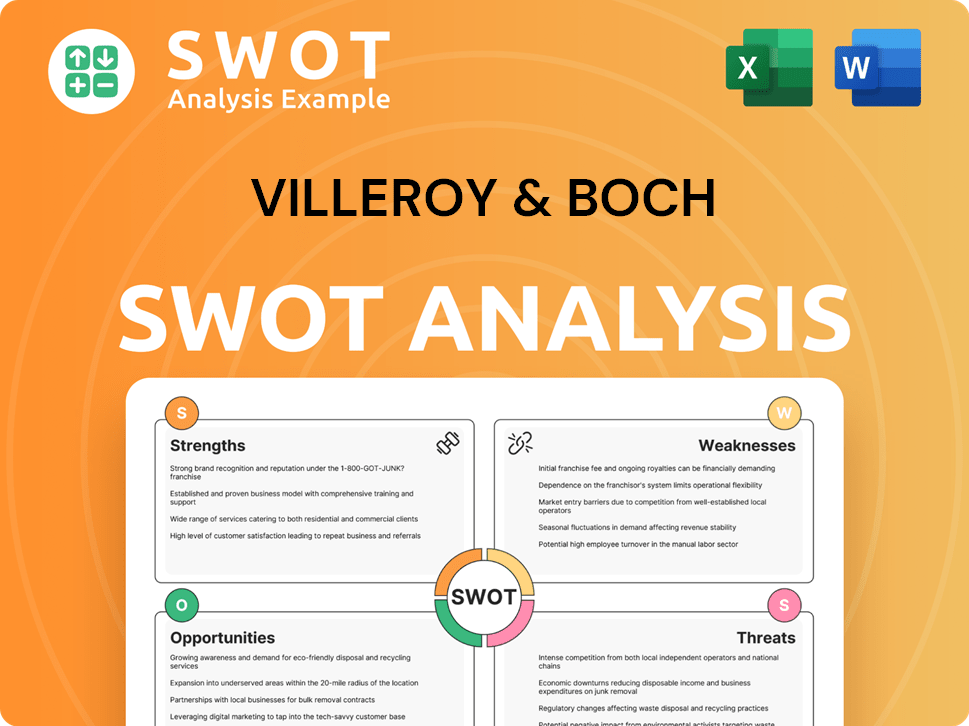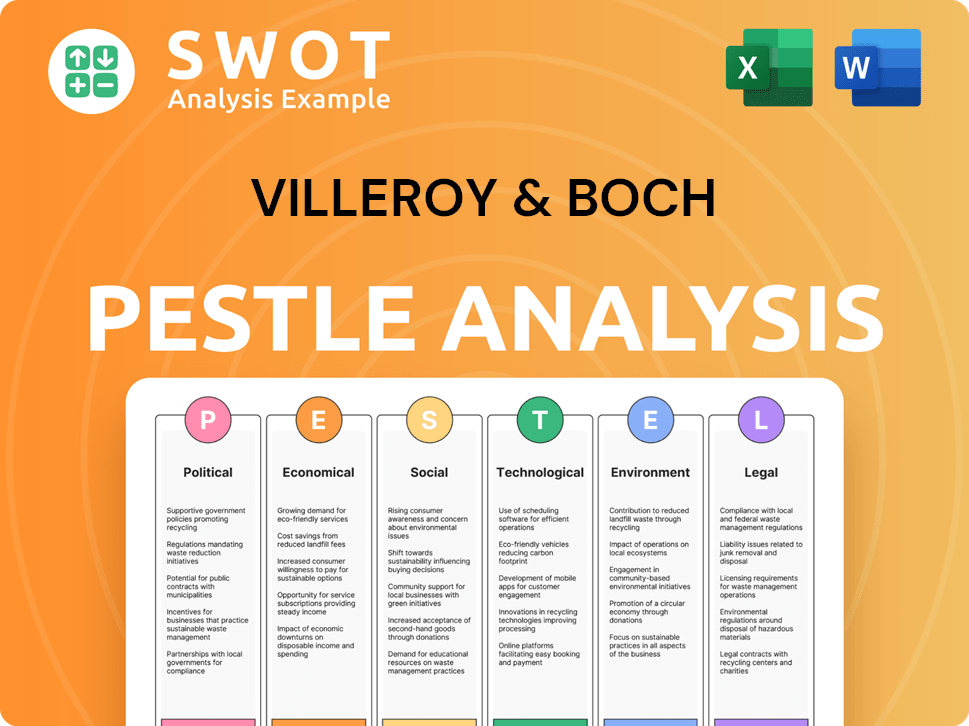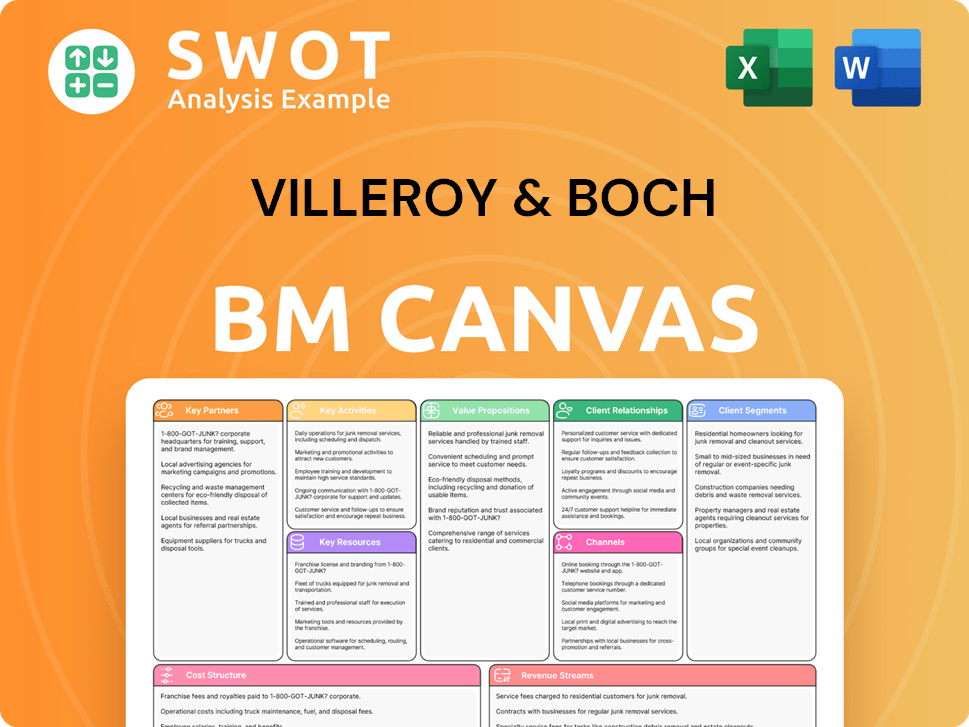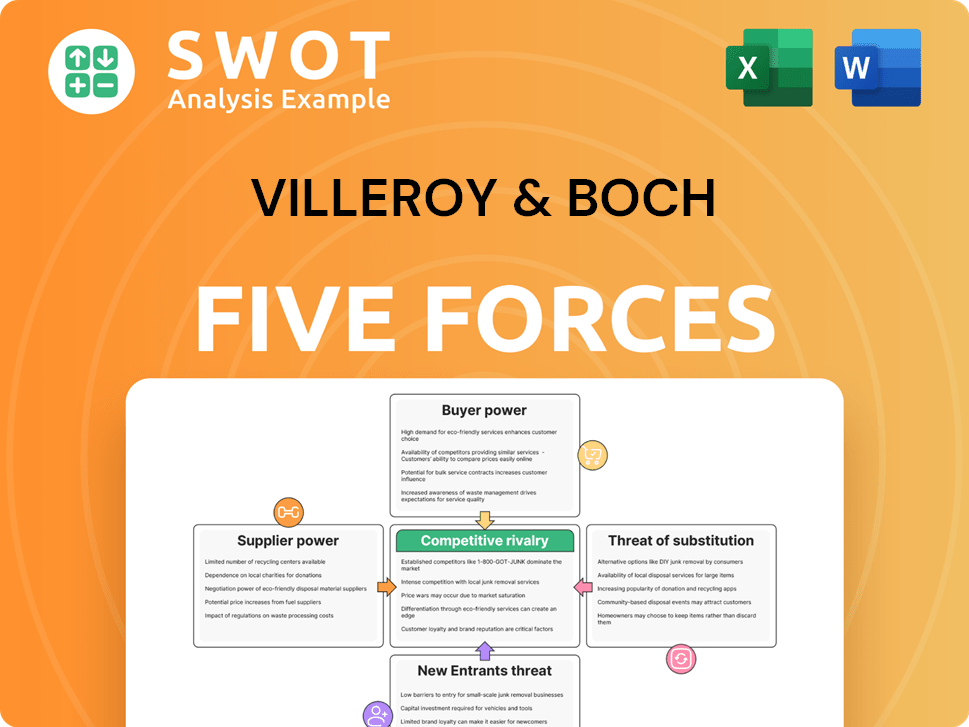Villeroy & Boch Bundle
How Does Villeroy & Boch Stack Up in Today's Market?
For over 270 years, Villeroy & Boch has been a cornerstone of the luxury home goods market. But in an ever-evolving landscape, how does this iconic brand maintain its edge? This analysis dives deep into the Villeroy & Boch SWOT Analysis, exploring its competitive landscape, and dissecting its position within the industry.

From its humble beginnings, Villeroy & Boch's journey reflects remarkable adaptability. The recent acquisition of Ideal Standard significantly reshaped its market presence, boosting revenue and expanding its reach. This exploration offers a comprehensive Villeroy & Boch market analysis, identifying key Villeroy & Boch competitors, and assessing its Villeroy & Boch competitive advantages and disadvantages to understand its future trajectory.
Where Does Villeroy & Boch’ Stand in the Current Market?
Villeroy & Boch holds a strong market position as a leading premium supplier in the Dining & Lifestyle and Bathroom & Wellness sectors. The company's core operations revolve around these two divisions, offering a wide range of products from ceramic sanitary ware and bathroom furniture to tableware and kitchen products. Its value proposition lies in providing high-quality, premium products that cater to a diverse customer base, ranging from affordable to luxury segments.
In 2024, the group achieved record revenues of €1.42 billion, a substantial increase driven by strategic acquisitions. This growth underscores the company's ability to adapt and expand its market presence, particularly through the integration of Ideal Standard. This strategic move has significantly strengthened its position in the Bathroom & Wellness division, allowing it to compete more effectively in the global market. The company's focus on innovation, design, and sustainability further enhances its market appeal.
The company's success is also reflected in its diversified sales channels and its ability to cater to both the premium and smart premium segments. The integration of Ideal Standard has broadened its international footprint and increased its competitiveness, making its business model more resilient. To learn more about their growth strategies, you can explore the Growth Strategy of Villeroy & Boch.
Villeroy & Boch's market share in the premium segments of both Dining & Lifestyle and Bathroom & Wellness remains significant. In 2024, the company's revenue reached €1.42 billion, a substantial increase from the previous year. The Bathroom & Wellness division saw an 89.7% increase in revenue, reaching €1,098.9 million.
The company offers a wide range of products, from ceramic sanitary ware to tableware. The product range caters to different customer segments, from affordable to premium. The integration of Ideal Standard has allowed Villeroy & Boch to target the smart premium segment, particularly excelling in large-scale projects.
Villeroy & Boch has a strong global presence, with significant market share in Europe, Asia-Pacific, and the Americas. The acquisition of Ideal Standard strengthened its presence, especially in Western and Southern Europe. Sales in Eastern Europe increased by 74.8% in 2024.
In 2024, Villeroy & Boch invested €58.3 million in modernizing production sites and enhancing brand presence. The Dining & Lifestyle division maintained stable revenue at €319.3 million. The company's financial performance reflects its strategic investments and market adaptability.
Villeroy & Boch's competitive advantages include its strong brand recognition, premium product offerings, and diversified market presence. The company's market position is strengthened by its ability to cater to both premium and smart premium segments, as well as its focus on innovation and sustainability. The integration of Ideal Standard has broadened its international footprint and increased its competitiveness.
- Strong Brand Recognition: Established reputation for quality and design.
- Premium Product Offerings: High-end products that command premium pricing.
- Diversified Market Presence: Operations in both Dining & Lifestyle and Bathroom & Wellness.
- Strategic Acquisitions: Integration of Ideal Standard to expand market reach.
Villeroy & Boch SWOT Analysis
- Complete SWOT Breakdown
- Fully Customizable
- Editable in Excel & Word
- Professional Formatting
- Investor-Ready Format

Who Are the Main Competitors Challenging Villeroy & Boch?
The Villeroy & Boch competitive landscape is shaped by a diverse group of rivals across its key segments: tableware, bathroom, and tiles. Understanding these competitors is crucial for a comprehensive Villeroy & Boch market analysis. The company faces both direct and indirect competition, necessitating a multifaceted approach to maintain and grow its market position.
Villeroy & Boch's competitors challenge the brand through various strategies, including product innovation, pricing, and marketing. The competitive dynamics are also influenced by new entrants and strategic alliances. For instance, the acquisition of Ideal Standard has significantly strengthened its presence in key markets, allowing it to compete more effectively, especially in the fittings segment.
The ceramic tableware market, a key area for Villeroy & Boch, was valued at USD 12.4 billion in 2024 and is projected to reach USD 22.2 billion by 2034, highlighting the importance of understanding the competitive environment. This growth underscores the need for Villeroy & Boch to continuously adapt and innovate to stay ahead.
In the bathroom and wellness sector, key direct competitors include Ideal Standard International, Grohe, Duravit, and Kohler. These brands offer similar products and compete for market share in the same customer segments.
Other notable competitors in the broader home furnishings and ceramic products market include Surya Toto Indonesia, Lenox, Official Rosenthal, WMF, Portmeirion Group, Meissen, Noritake Company Limited, and RAK Ceramics.
Competitors employ various strategies. For example, Grohe competes in the industrial goods and services space, similar to Villeroy & Boch. Lenox, also operates in the industrial goods and services industry.
FM Mattsson Mora Group designs, manufactures, and sells faucets and accessories, directly competing with Villeroy & Boch's bathroom offerings. This highlights the importance of product differentiation and innovation.
Villeroy & Boch's acquisition of Ideal Standard has significantly bolstered its presence in key markets. This has allowed it to compete more effectively, particularly in the fittings segment. Read more about the company's history in Brief History of Villeroy & Boch.
The ceramic tableware market is driven by evolving consumer tastes and a growing emphasis on aesthetics and sustainability. This trend influences the Villeroy & Boch industry and its competitors.
Villeroy & Boch has a strong brand reputation and a wide product range. However, it faces competition from both established and emerging players. Understanding these Villeroy & Boch rivals is crucial for strategic planning.
- Villeroy & Boch's established brand and product diversification provide a competitive edge.
- The company's focus on innovation in bathroom design and sustainability initiatives can differentiate it from competitors.
- The company's pricing strategies need to be competitive to maintain market share.
- The global tableware market, valued at USD 12.4 billion in 2024, presents both opportunities and challenges.
Villeroy & Boch PESTLE Analysis
- Covers All 6 PESTLE Categories
- No Research Needed – Save Hours of Work
- Built by Experts, Trusted by Consultants
- Instant Download, Ready to Use
- 100% Editable, Fully Customizable

What Gives Villeroy & Boch a Competitive Edge Over Its Rivals?
The Target Market of Villeroy & Boch benefits from a strong competitive position, built on a foundation of brand heritage, innovation, and strategic expansion. Founded in 1748, the company has cultivated a premium brand image, recognized globally for quality and design. This long-standing reputation is a key asset in a market where consumer trust and brand loyalty are paramount.
Continuous innovation, including the development of technologies like 'TwistFlush,' and a focus on design excellence, further enhance its competitive edge. The company consistently introduces new products and technologies, ensuring its offerings remain at the forefront of market trends. This commitment to innovation is evident in its numerous design awards, such as the German Design Award for the Afina collection in 2025, and Red Dot Design Awards for its Tableware and Bath & Wellness divisions.
The strategic acquisition of Ideal Standard in March 2024 significantly bolstered its competitive position. This move strengthened the Bathroom & Wellness Division and expanded its product portfolio, particularly in fittings. Geographical expansion, complementing existing strengths in Central and Northern Europe and Asia with Ideal Standard's presence in the UK, Italy, and the Middle East/North Africa region, has been a key driver of growth.
With over 270 years of history, the brand is synonymous with quality and timeless design. This long-standing tradition is a significant asset in established and growth markets. The strong brand equity allows the company to command premium pricing and maintain customer loyalty in the competitive landscape.
The company consistently introduces new products and technologies, such as 'TwistFlush'. The commitment to design and technical advancements ensures that its products remain at the forefront of market trends. Numerous design awards, including the German Design Award for the Afina collection in 2025, highlight its dedication to excellence.
Offers a wide range of products across Tableware and Bath & Wellness divisions. This diversification reduces dependence on any single product category and allows the company to cater to a broad customer base. The recent acquisition of Ideal Standard has expanded the product range further.
The company has a strong presence in Europe, Asia, and the Americas. Strategic geographical expansion, particularly the acquisition of Ideal Standard, has doubled the Group's revenues outside Germany, Austria, and Switzerland in 2024. This global footprint enables the company to tap into diverse markets and reduce geographical risk.
The Villeroy & Boch competitive landscape is shaped by its core strengths, including a rich brand heritage and continuous innovation. The company's focus on high-quality ceramic materials, known for their durability, contributes to customer loyalty. Strategic moves, such as the acquisition of Ideal Standard, have expanded its market reach and product offerings, enhancing its position against Villeroy & Boch competitors.
- Brand Heritage: Over 270 years of history, establishing a premium brand image.
- Innovation: Continuous introduction of new products and technologies, such as 'TwistFlush.'
- Strategic Acquisitions: The Ideal Standard acquisition strengthened the Bathroom & Wellness Division.
- Digitalization: Optimizing product content management, improving time-to-market.
Villeroy & Boch Business Model Canvas
- Complete 9-Block Business Model Canvas
- Effortlessly Communicate Your Business Strategy
- Investor-Ready BMC Format
- 100% Editable and Customizable
- Clear and Structured Layout

What Industry Trends Are Reshaping Villeroy & Boch’s Competitive Landscape?
The Villeroy & Boch competitive landscape is heavily influenced by industry trends, technological advancements, and economic shifts. The company faces challenges from subdued construction sector growth and global trade issues, while also benefiting from opportunities like acquisitions and expanding into new markets. Understanding the Villeroy & Boch market analysis is crucial for assessing its future prospects.
The Villeroy & Boch industry is seeing a rise in consumer interest in home dining and eco-friendly products. The company's ability to adapt to these trends, alongside navigating economic uncertainties, will determine its success. The company's strategy includes modernizing production and focusing on key growth areas.
The ceramic tableware market was valued at USD 12.4 billion in 2024 and is projected to reach USD 22.2 billion by 2034. The global ceramics market, valued at USD 262.80 billion in 2024, is expected to grow to USD 421.88 billion by 2033, driven by construction and home aesthetics. These trends highlight the importance of sustainability and consumer preferences for home dining.
Potential threats include subdued construction sector development and impacts from US tariff policies and geopolitical conflicts. The decline in brick-and-mortar sales presents a challenge, requiring a focus on e-commerce and project businesses. Villeroy & Boch's competitive advantages and disadvantages are closely tied to its ability to respond to these challenges.
The acquisition of Ideal Standard broadens the company's international footprint and diversifies sales channels. Expanding the product portfolio, particularly in fittings and ceramic sanitary ware, and a stronger presence in project-driven markets offer significant growth potential. Villeroy & Boch's marketing strategies compared to rivals are crucial for capitalizing on these opportunities.
The company is investing in modernizing and automating its production facilities and enhancing its brand presence through initiatives like Villeroy & Boch World. Participation in events like Expo 2025 Osaka and ISH 2025 showcases new products. For 2025, the company forecasts an increase in consolidated revenue in the high single-digit percentage range.
Villeroy & Boch's strategies to stay competitive involve focusing on clearly defined regional priorities, key product categories, and high-growth sales channels. The company is also exploring 3D printing in ceramics to enhance production. For more insights, explore the Revenue Streams & Business Model of Villeroy & Boch.
- Modernization and automation of production facilities.
- Expansion through acquisitions and new market entries.
- Focus on e-commerce and project-based sales.
- Enhancing brand presence and product innovation.
Villeroy & Boch Porter's Five Forces Analysis
- Covers All 5 Competitive Forces in Detail
- Structured for Consultants, Students, and Founders
- 100% Editable in Microsoft Word & Excel
- Instant Digital Download – Use Immediately
- Compatible with Mac & PC – Fully Unlocked

Related Blogs
- What are Mission Vision & Core Values of Villeroy & Boch Company?
- What is Growth Strategy and Future Prospects of Villeroy & Boch Company?
- How Does Villeroy & Boch Company Work?
- What is Sales and Marketing Strategy of Villeroy & Boch Company?
- What is Brief History of Villeroy & Boch Company?
- Who Owns Villeroy & Boch Company?
- What is Customer Demographics and Target Market of Villeroy & Boch Company?
Disclaimer
All information, articles, and product details provided on this website are for general informational and educational purposes only. We do not claim any ownership over, nor do we intend to infringe upon, any trademarks, copyrights, logos, brand names, or other intellectual property mentioned or depicted on this site. Such intellectual property remains the property of its respective owners, and any references here are made solely for identification or informational purposes, without implying any affiliation, endorsement, or partnership.
We make no representations or warranties, express or implied, regarding the accuracy, completeness, or suitability of any content or products presented. Nothing on this website should be construed as legal, tax, investment, financial, medical, or other professional advice. In addition, no part of this site—including articles or product references—constitutes a solicitation, recommendation, endorsement, advertisement, or offer to buy or sell any securities, franchises, or other financial instruments, particularly in jurisdictions where such activity would be unlawful.
All content is of a general nature and may not address the specific circumstances of any individual or entity. It is not a substitute for professional advice or services. Any actions you take based on the information provided here are strictly at your own risk. You accept full responsibility for any decisions or outcomes arising from your use of this website and agree to release us from any liability in connection with your use of, or reliance upon, the content or products found herein.